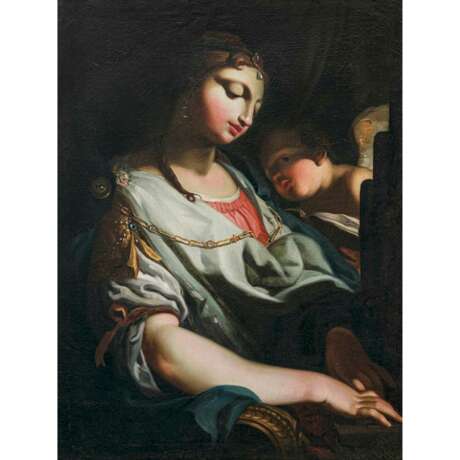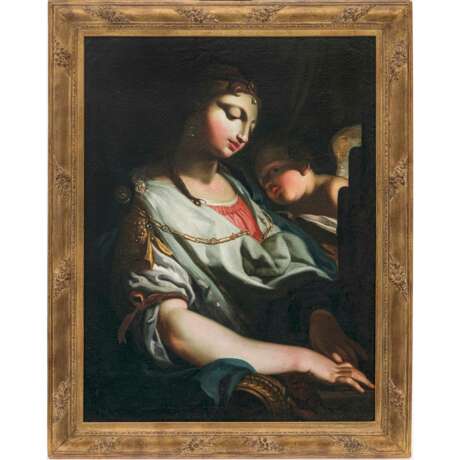ID 1087572
Lot 618 | Peter Strudel, zugeschrieben. Hl. Cäcilia
Estimate value
€ 6 000 – 8 000
Hl. Cäcilia
Die Heilige bei Kerzenlicht dem Orgelspiel hingegeben, bei ihr ein Engel mit Notenheft. Vor Vorhangdraperie. Auf dem Keilrahmen hs. Eigentumsvermerk "Doge e Senatori Del Mag[istra]to Supremo / Proprietari del Quadro SS. Cecilia di R[om]a" mit Stadtwappen Genua. Öl auf Lwd. 88,5 x 67,5 cm. Doubliert. Rest. Min. besch. Rahmen (103 x 81,5 cm).
Die aus der römischen Patrizierfamilie der Cäcilier stammende Heilige wird - ihrer römischen Abstammung entsprechend - in antikisierender Kleidung und mit kostbarem Schmuck dargestellt. Ihr Attribut ist die Orgel, die Heilige Cäcilia gilt seit dem 15. Jahrhundert als Patronin der Kirchenmusik.
Peter Strudel, Maler und Bildhauer, wurde in eine Bildhauerfamilie hineingeboren. Nach einer ersten Ausbildung folgte er seinem älteren Bruder Paul nach Venedig. Zwischen 1680 und 1685 scheint er sich dort in der Werkstatt Johann Carl Loths aufgehalten zu haben. Seine venezianische Prägung wird Strudel stets beibehalten, wenngleich er seine Kunst um Inspirationen aus anderen Kunstlandschaften bereichert. Bald geht er zu einer flüchtigeren Malweise über, wie sie für die neapolitanische Malerei charakteristisch ist. Luca Giordano ist hier eindeutiger Ideengeber, der für seine "Fa presto"-Malerei berühmt war und ist. Während späterer Italienaufenthalte befasst sich Peter Strudel mit der zeitgenössischen römischen Malerei, auch die bolognesische Kunst regt ihn immer wieder an.
Bereits 1687 ist Peter Strudel mit einer eigenen Werkstatt nachweisbar. Wilhelm von der Pfalz, der Schwager Kaiser Leopolds I. und Förderer Strudels, erhebt ihn zum "Cavalière" und "Cameriere dhonore". Seit 1688 beschäftigt sich Strudel mit seinem bedeutendsten Projekt, der Gründung einer Kunstakademie in Wien. Im Jahr darauf wird der Künstler zum Hof- und Kammermaler ernannt, erwirbt in der Alservorstadt ein Grundstück und ein Haus: den "Strudelhof". Im Herbst 1688 eröffnet Peter Strudel dort seine "Accademia del disegno del naturale", 1692 wird diese Akademie vom Kaiser urkundlich anerkannt. Aus Strudels Akademie wird schließlich die Wiener Akademie der Bildenden Künste hervorgehen.
Das vorliegende Gemälde, das man auf den ersten Blick glaubt, als italienisches Werk klassifizieren zu sollen, weist deutliche stilistische Bezüge zur bolognesischen Malerei auf: das ausgeprägte und raffinierte Chiaroscuro, die Behandlung der Physiognomien und besonders die spezifische Modellierung der Augenpartie der Heiligen durch eine dramatische und markante Schattengebung. Darin vergleichbar ist es aber auch mit jenem Werk Peter Strudels, das in der NEUMEISTER-Auktion 408 mit Kat.-Nr. 1018 versteigert wurde. Bei "Judith mit dem Haupt des Holofernes" findet sich eine vergleichbar stark ausgeprägte Lokalfarbigkeit, Licht und Schatten sind dramatisch definiert. Die Rötungen auf Wangen, Dekolletee und an den Armen bestimmen bei beiden Gemälden das delikate Inkarnat. Der aus dem Schatten in das Kerzenlicht hinzukommende Engel bei der "Hl. Cäcilia" kann in seiner Art bei weiteren Werken Peter Strudels nachgewiesen werden. Und schließlich kann auf die übereinstimmende charakteristische Gestaltung der Hände, speziell der Finger, die größte Elastizität offenbaren, verwiesen werden.
| Artist: | Peter Strudel (1660 - 1714) |
|---|---|
| Auction house category: | Paintings 15th -18th century |
| Artist: | Peter Strudel (1660 - 1714) |
|---|---|
| Auction house category: | Paintings 15th -18th century |
| Address of auction |
Kunstauktionshaus Neumeister Barer Str. 37 80799 München Germany | ||||||||||||||
|---|---|---|---|---|---|---|---|---|---|---|---|---|---|---|---|
| Preview |
| ||||||||||||||
| Phone | 089 231710-20 | ||||||||||||||
| Fax | 089 231710-50 | ||||||||||||||
| Buyer Premium | 30% | ||||||||||||||
| Conditions of purchase | Conditions of purchase | ||||||||||||||
| Business hours | Business hours
|





